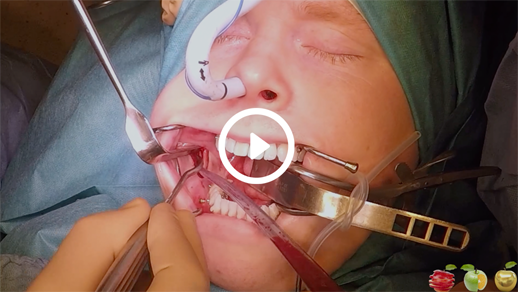Dysgnathia treatment is typically divided into the following segments.
If an indication for a corrective jaw surgery is made, the patient is referred to an oral and maxillofacial surgeon.
Follow-up examination and preparation of the surgical opinion for health insurance.
Application for cost absorption of an interdisciplinary orthodontic treatment.
Almost half of our patients require surgical expansion of the jaw due to dental crowding, particularly in the upper jaw. Healthy teeth therefore do not need to be removed. A jaw that is too small requires a surgical jaw expansion. Both methods aim to increase the available room in order to facilitate the formation of dental arches and prevent the unnecessary removal of permanent teeth. The inpatient hospital stay amounts to 2 days, followed by 1 week of sick leave.
Before corrective surgery can take place, an orthodontist has to shape and harmonize the dental arches. The full extent of dysgnathia can only be identified once the teeth have been aligned and balanced with the masticatory system. Orthodontic shaping of the dental arches can be carried out with brackets or Invisalign splints. Duration 8-12 months.
Planning and implementation of the corrective surgery, under general anesthesia and inpatient hospitalization. The duration of the inpatient stay is approx. 4-5 days, with a subsequent sick leave of 2-3 weeks. During this phase, patients should only eat soft foods and not carry out any physical activity. During this time, a weekly follow-up examination is carried out.
Orthodontic aftercare begins approx. 6 weeks post-surgery. This is carried out to fine-tune the bite and yield a stable result. This phase is the so-called "finishing" phase. Duration approx. 6 months.
Removal of the metal plates approx. 12 months post-surgery This is carried out within a brief inpatient stay of approx. 2 days. During this procedure (optional), additional patient wishes can be implemented (dental implants, rhinoplasty, genioplasty, etc.). Work can generally be resumed after 7 days.

Our 25 years of expertise make this a confident and routine surgery for us and a relatively mild one for you. The procedure can be recommended to patients of all ages. Upper and lower jaw surgeries are carried out in the neighboring Hochtaunus Clinic.
You can schedule an in-depth consultation to ask questions and find out everything you want to know. Based on clinical case studies, we are able to give you comparable results before providing the best solution for you.
The surgery is prepared for with the help of a computer-aided virtual surgery simulation to determine the best functional and aesthetically pleasing result. Models of both jawbones are produced, inserted and correctly positioned using temporomandibular joint analysis. To complete this, so-called splints (bite plates) are 3D-printed using the CAD-CAM technique to help position the new jawbones during surgery.
The procedure is carried out while the patient is under anesthesia to avoid pain and stress. We only gain access through the oral cavity in order to avoid external scars.
Special low-impact techniques are used, allowing the patient to open his/her mouth immediately after the procedure. Speaking, eating and oral hygiene are hardly affected.
Our clinic uses ultrasound instruments for a low-impact separation of the bones, electric wire loops for blood-free preparation and a special technique, developed by us, for separating the tooth-bearing lower jaw section from the joint section without damaging the lower jaw. The bone is moved under contact, avoiding larger gaps.
All these measures help us keep swelling to a minimum, shorten the inpatient stay and allow quick recovery.

The special surgical technique, in conjunction with the surgeon’s expertise and our well-rehearsed team reduces the corrective surgery down to approx. 60 minutes.
If both jawbones are corrected, the surgery takes approx. 120 minutes. Thanks to the particularly low-impact surgery, no blood products are needed. Desired results are generally achieved with one surgical procedure.
As a result of the tissue-conserving surgical technique, there is generally no discoloration (hematoma) and only minor painful symptoms after surgery. However, the face does swell up, similar to a wisdom tooth removal. Optimum postoperative care and special physiotherapy ensure that all signs of surgery quickly disappear.
The inpatient stay lasts no longer than five to six days. After approximately six weeks, the jaw is ready for normal use. Until then, you should only eat soft foods. You should plan another 10-14 days for recovery after you’re dismissed from the hospital.